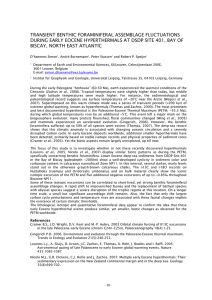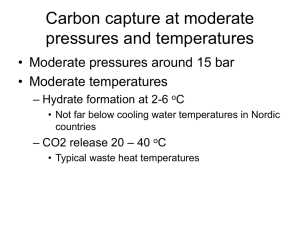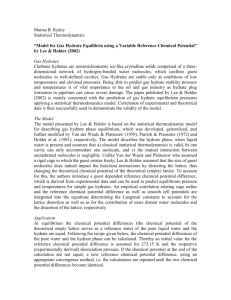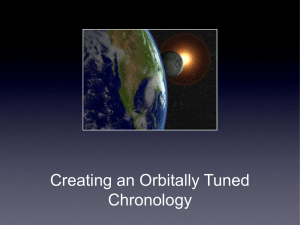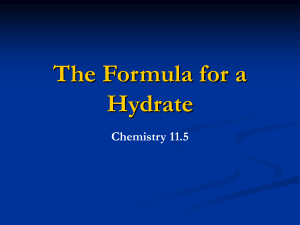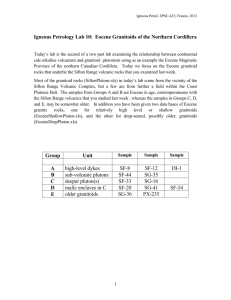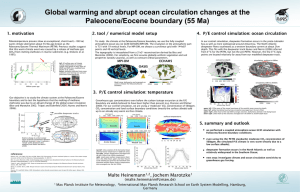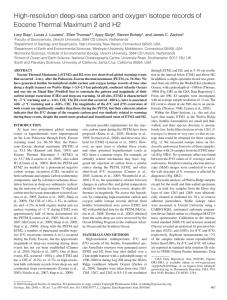Lunt_EGU_2011
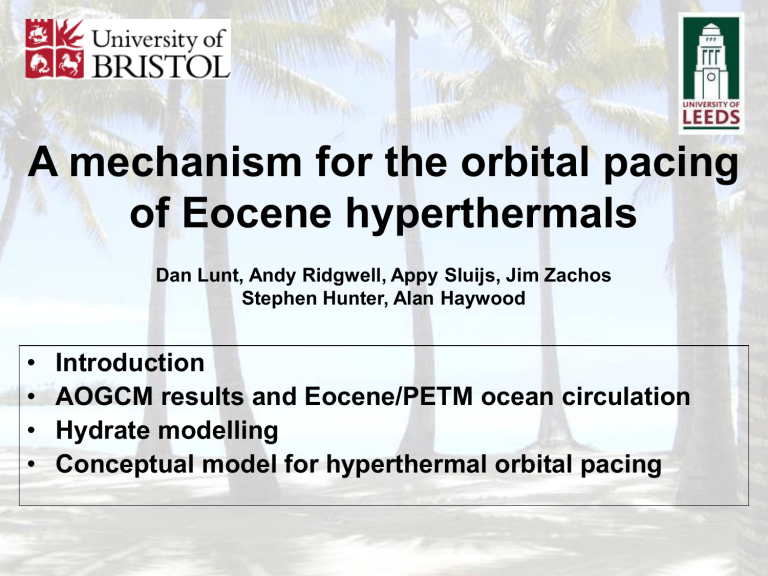
A mechanism for the orbital pacing of Eocene hyperthermals
Dan Lunt, Andy Ridgwell, Appy Sluijs, Jim Zachos
Stephen Hunter, Alan Haywood
• Introduction
• AOGCM results and Eocene/PETM ocean circulation
• Hydrate modelling
• Conceptual model for hyperthermal orbital pacing
Orientation…
Palaeocene-Eocene
Thermal Maximum
Zachos et al, Nature,
2008
Causes of PETM have been debated – implications for carbon input and therefore climate sensitivity
Dunkley Jones et al, 2010
One hypothesis: release of methane hydrates due to enhanced warming:
…and “data”: some evidence from ocean-only modelling.
Bice and Marotzke, 2004
Nunes and Norris,
2006
So, what did we do? – Fully coupled HadCM3(L).
(1) Palaeogeography
Topography
Vegetation
(2) CO
2
1680ppmv = 6*
1120ppmv = 4*
560ppmv = 2*
Zachos et al, Nature,
2008
Global mean temperature vs
CO
2 forcing
Runs at 1,2,4,6 * pre-industrial CO
2
. ~3500 years
Normalised Surface Temperature, Eocene 2*-1*, 4*-1*, 6*-1*
‘Kink’ in HadCM3 climate sensitivity
Streamfunctions: 1*,2*,4*,6*
Normalised 1km ocean Temperature, Eocene 2*-1*, 4*-1*, 6*-1*
Mixed Layer depth, 1* 2*, 4*, 6*
DJF:
JJA:
Implications for PETM:
Bice and Marotzke, 2004
Conclusions (1)
• Eocene model shows fairly linear surface temperature response to CO2, but…
• Deep ocean warms non-linearly, associated with reduction in deep water formation and switch in ocean circulation.
• Implications for hydrates: initial forcing (e.g. volcanic) could cause ‘run-away’ positive feedbacks.
• Supported by other modelling work (Winguth et al,
2010)
Lunt et al, Geology, 2010.
Evidence for multiple hyperthermals…
And orbital pacing….
See also Westerhold et al.,
Lourens et al
“Hence, we suggest that the extreme seasonal contrast at both hemispheres during eccentricity maxima increased intermediate seawater temperatures, thereby triggering the release of oceanic methane hydrates.”
6 Additional simulations with orbital pertubations, 1000years in length:
Maximum seasonality: obliquity=0.43 rad, eccentricity=0.054
Minimum seasonality: obliquity=0.38 rad, eccentricity=0
Mixed layer depth, JJA
Minimum seasonality
1km Temperature difference,
Minimum seasonality minus
Maximum SH seasonality
Maximum SH seasonality
Time-dependent sediment hydrate model of Davie and Buffett (2001).
Simulates hydrate evolution, given a bottom-water temperature forcing, plus other
(poorly constrained) variables.
Here: depth = 1500m, at ‘bullseye’ of orbitally-induced temperature anomaly
300
250
200
150
100
50
0
6 6.2
6.4
6.6
6.8
7
Millions of years
7.2
7.4
7.6
7.8
8
Conceptual ‘threshold’ model for combined CO2 and orbital impacts on circulation, hydrate, and temperature,
Informed by GCM and hydrate modelling
Conclusions (2)
• GCM responds in a similar way to orbital forcing as to
CO
2 forcing.
• Conceptual model, informed by GCM and hydrate model results, produces results qualitatively in agreement with data.
• Therefore, we propose a possible mechanism for orbital pacing of hyperthermals, via hydrate destabilisation
Warm Climates of the Past
– a lesson for the future?
10 - 11 October 2011
The Royal Society, London
Speakers include:
Jim Hansen, Bette Otto Bliesner, Jeff Kiehl, Paul Valdes
Possible reasons for circulation switch:
Comparison with data:
Temperature ANOMALIES, PETM – ‘backgound’ Eocene
Eocene Model Intercomparison Project (‘EoMIP’) results
Lunt et al,
Geology,
2010
Heinemann et al,
Climate of the Past,
2009
Winguth et al,
Journal of
Climate, 2010
Huber et al, PPP,
2006
Roberts et al, EPSL,
2009
Panchuk et al, Geology,
2008
280 560 1120 2240 4480 ppmv
What are the reasons for the differences between models…?
And the differences between models and data…?
